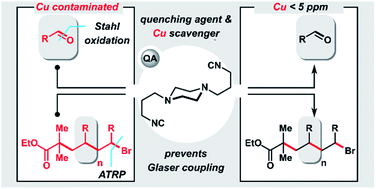An isocyanide ligand for the rapid quenching and efficient removal of copper residues after Cu/TEMPO-catalyzed aerobic alcohol oxidation and atom transfer radical polymerization†
Abstract
Transition metal catalysts play a prominent role in modern organic and polymer chemistry, enabling many transformations of academic and industrial significance. However, the use of organometallic catalysts often requires the removal of their residues from reaction products, which is particularly important in the pharmaceutical industry. Therefore, the development of efficient and economical methods for the removal of metal contamination is of critical importance. Herein, we demonstrate that commercially available 1,4-bis(3-isocyanopropyl)piperazine can be used as a highly efficient quenching agent (QA) and copper scavenger in Cu/TEMPO alcohol aerobic oxidation (Stahl oxidation) and atom transfer radical polymerization (ATRP). The addition of QA immediately terminates Cu-mediated reactions under various conditions, forming a copper complex that can be easily separated from both small molecules and macromolecules. The purification protocol for aldehydes is based on the addition of a small amount of silica gel followed by QA and filtration. The use of QA@SiO2 synthesized in situ results in products with Cu content usually below 5 ppm. Purification of polymers involves only the addition of QA in THF followed by filtration, leading to polymers with very low Cu content, even after ATRP with high catalyst loading. Furthermore, the addition of QA completely prevents oxidative alkyne–alkyne (Glaser) coupling. Although isocyanide QA shows moderate toxicity, it can be easily converted into a non-toxic compound by acid hydrolysis.



 Please wait while we load your content...
Please wait while we load your content...